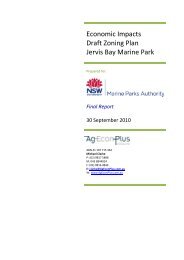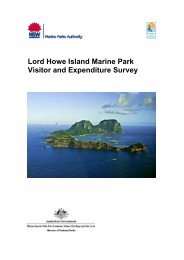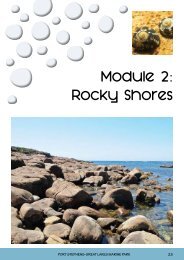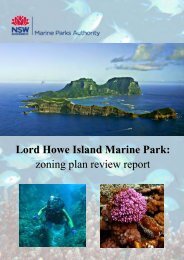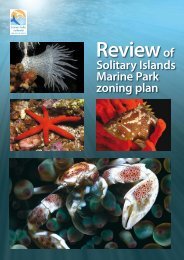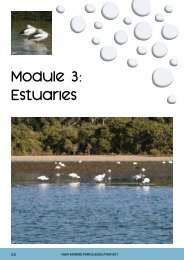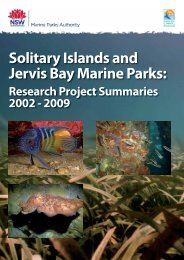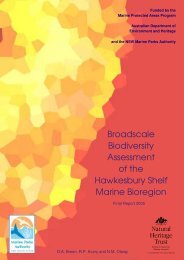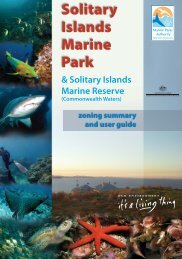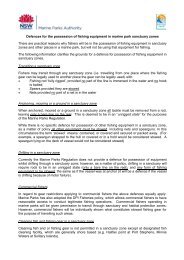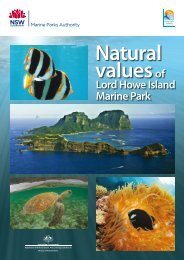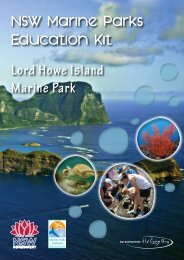Natural values of the Solitary Islands Marine Park - Marine Parks ...
Natural values of the Solitary Islands Marine Park - Marine Parks ...
Natural values of the Solitary Islands Marine Park - Marine Parks ...
- No tags were found...
You also want an ePaper? Increase the reach of your titles
YUMPU automatically turns print PDFs into web optimized ePapers that Google loves.
22 <strong>Natural</strong> <strong>values</strong> <strong>of</strong> <strong>the</strong> <strong>Solitary</strong> <strong>Islands</strong> <strong>Marine</strong> <strong>Park</strong>Figure 29.Stingray buried in sand.Figure 30.Diggers Camp rockplatform.Figure 31.Boulder habitat ArrawarraHeadland.In general, <strong>the</strong> abundance and diversity <strong>of</strong> sessilemacr<strong>of</strong>auna decreases with depth, with deepunconsolidated habitats containing few octocorals(s<strong>of</strong>t corals and sea fans) and ascidians (Bax andWilliams 2001, Beaman et al 2005). While <strong>the</strong>re islittle information on <strong>the</strong> distribution and diversity<strong>of</strong> s<strong>of</strong>t-sediment assemblages in <strong>the</strong> SIMP region, itis likely that <strong>the</strong> considerable structural complexityseen in <strong>the</strong> swath-mapping data will influence <strong>the</strong>patterns <strong>of</strong> faunal assemblages in this habitat.The distribution and structure <strong>of</strong> invertebratesare also likely to influence fish assemblages, givenfindings in o<strong>the</strong>r regions. Areas <strong>of</strong> low structuralcomplexity on <strong>the</strong> inner-shelf region <strong>of</strong> sou<strong>the</strong>rnNSW differ significantly in fish species from morestructurally complex unconsolidated habitatscontaining sponges, sea-whips and bryzoans(Williams and Bax 2001).A very diverse range <strong>of</strong> fish, sharks, rays andcrustaceans occur in s<strong>of</strong>t-sediment habitats on <strong>the</strong>continental shelf (Figure 29). See NSW Department<strong>of</strong> Primary Industries 2004 for details <strong>of</strong> speciescomposition; distribution; and biology such as growth rate, longevity, diet andfecundity <strong>of</strong> many <strong>of</strong> <strong>the</strong>se species.4.3 Rocky intertidal habitatIntertidal rocky shores occupy a zone <strong>of</strong> transition between marine and terrestrialenvironments, and include <strong>the</strong> intertidal zone and <strong>the</strong> adjacent wave surge zone.These habitats are <strong>of</strong>ten characterised by local variations in <strong>the</strong> distribution <strong>of</strong>organisms determined by levels <strong>of</strong> exposure, wave action, biological interactions and<strong>the</strong> history <strong>of</strong> disturbances at individual sites (Underwood and Chapman 1995, Otway1999).The geomorphic structure <strong>of</strong> rocky shores can vary greatly, depending on:• <strong>the</strong> dominant rock type and structure such as a platform, cobble or boulder (Figs. 30and 31);• exposure, for example, protected or exposed;• slope, for example, steep, inclined or flat (Banks and Skilleter 2002, Otway andMorrison in prep).Rock pools, crevices and shallow gulches are alsoimportant areas as <strong>the</strong>y generally retain seawaterduring low tide. There is evidence that an increasein <strong>the</strong> structural complexity <strong>of</strong> <strong>the</strong> rocky shore canresult in an increase in <strong>the</strong> diversity <strong>of</strong> species withinan area (Smith and James 1999, Smith 2005, Otwayand Morrison in prep).



